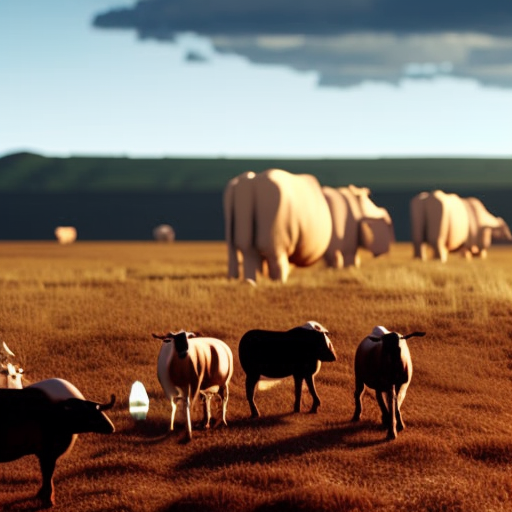
Substituting Animal Products with Sustainable Alternatives to Achieve Sustainable Development Goals
According to new research published in Nature Communications, substituting half of the global consumption of animal products, such as pork, chicken, beef, and milk, with more sustainable alternatives could significantly reduce the conversion of forests and natural land for agriculture. This dietary shift towards plant-based alternatives has the potential to almost fully halt land-use change and the associated greenhouse gas emissions caused by the global supply chain of animal-sourced products. The study emphasizes the importance of achieving the Sustainable Development Goals (SDGs) through sustainable dietary choices.
Impact of Animal Products on Land Use and Greenhouse Gas Emissions
Animal-sourced products and their global supply chain are major contributors to global land-use change and the resulting greenhouse gas emissions. The study highlights the need for a shift towards more sustainable alternatives, such as soy protein and vital wheat gluten, to reduce these environmental impacts. By replacing a meat- and dairy-heavy diet with plant-based alternatives, greenhouse gas emissions associated with agriculture and land-use change could be reduced by 31%.
Regional Variations in Environmental Benefits
The environmental benefits of a global dietary shift towards plant-based alternatives would vary across regions due to differences in population size, diets, agricultural production, and export levels. The study identifies China as a country that would experience the largest reductions in fertiliser use, water use, and emissions from agricultural land use. Sub-Saharan Africa and South America would have the largest share of restored land and subsequent carbon sequestration. These regional variations highlight the potential for achieving international agreements, such as the global land restoration target established by the Kunming-Montreal Global Biodiversity Framework, through changes in global consumption patterns.
New Plant-Based Alternatives
The production of animal-sourced foods, such as meat and milk, requires significant resources including land, water, and energy. This makes animal-sourced foods a major source of greenhouse gas emissions and harm to global biodiversity. The study highlights the emergence of new plant-based alternatives, such as soy protein, wheat gluten, and oat and almond milk, which mimic the taste and consistency of animal products. These alternatives are gaining popularity in various parts of the world, with plant-based alternatives representing 15% of the milk market in the US.
Environmental Benefits of Dietary Changes
The study assesses the environmental, economic, and nutritional impacts of substituting leading animal-sourced foods (pork, chicken, beef, and milk) with plant-based alternatives. The researchers created hypothetical plant-based recipes with similar nutrient profiles to their animal-derived counterparts. The study explores various scenarios of dietary changes and their impacts on greenhouse gas emissions, land-use change, biodiversity, crop prices, and food security. The results show that a 50% substitution of animal products with sustainable alternatives can significantly reduce the overall impacts on natural resources by 2050. This includes a decrease in global agricultural area by 12%, releasing 653 million hectares of land for other uses. Nitrogen use is halved, water use drops by 10%, and greenhouse gas emissions decrease by 2.1 billion tonnes of CO2-equivalent per year.
Land-Use Change and Regional Impacts
The study highlights the potential of beef substitution to have the greatest impact on reducing greenhouse gas emissions, land use, and biodiversity loss. However, the pace of dietary shifts may vary across different regions. The researchers analyze the model output for 13 countries and regions individually. In a 50% substitution scenario, China would account for 25% of global cropland abandonment and 22% of agricultural emissions reduction. Sub-Saharan Africa would have the potential to reduce natural land loss by 37% and land-use change emissions by 47%. The study provides maps illustrating the emissions change from the agricultural and land use sector by region, showing the potential regional impacts of dietary changes.
Enabling a Dietary Change
The study acknowledges that meat and milk alternatives do not pose any health risks by themselves. However, achieving a 50% substitution of animal-based foods with plant-based alternatives may lead to micronutrient deficiencies similar to those faced by vegetarians. The study suggests that expanding alternative plant-based foods should consider all micronutrient needs, such as omega-3 fatty acids, iron, zinc, iodine, calcium, vitamin D, and vitamin B12. The researchers also highlight the importance of further research on the long-term impacts of novel alternatives on health. They emphasize the value of meat alternatives in providing a similar experience to consumers who want to eat meat with fewer public health, environmental, and animal welfare harms.
Kozicka, M. (et al.) (2023) Feeding climate and biodiversity goals with novel plant-based meat and milk alternatives, Nature Communications, doi:10.1038/s41467-023-40899-2
SDGs, Targets, and Indicators
1. Which SDGs are addressed or connected to the issues highlighted in the article?
- SDG 2: Zero Hunger
- SDG 3: Good Health and Well-being
- SDG 6: Clean Water and Sanitation
- SDG 7: Affordable and Clean Energy
- SDG 12: Responsible Consumption and Production
- SDG 13: Climate Action
- SDG 14: Life Below Water
- SDG 15: Life on Land
The issues highlighted in the article, such as the environmental impacts of animal-sourced products, greenhouse gas emissions, land-use change, and biodiversity loss, are connected to several SDGs. These goals address various aspects of sustainable development, including food security, health, water and energy use, responsible consumption and production, climate action, and the preservation of terrestrial and aquatic ecosystems.
2. What specific targets under those SDGs can be identified based on the article’s content?
- Target 2.1: By 2030, end hunger and ensure access by all people, in particular the poor and people in vulnerable situations, including infants, to safe, nutritious and sufficient food all year round.
- Target 3.4: By 2030, reduce by one-third premature mortality from non-communicable diseases through prevention and treatment and promote mental health and well-being.
- Target 6.4: By 2030, substantially increase water-use efficiency across all sectors and ensure sustainable withdrawals and supply of freshwater to address water scarcity and substantially reduce the number of people suffering from water scarcity.
- Target 7.2: By 2030, increase substantially the share of renewable energy in the global energy mix.
- Target 12.2: By 2030, achieve the sustainable management and efficient use of natural resources.
- Target 13.2: Integrate climate change measures into national policies, strategies, and planning.
- Target 14.2: By 2020, sustainably manage and protect marine and coastal ecosystems to avoid significant adverse impacts, including by strengthening their resilience, and take action for their restoration to achieve healthy and productive oceans.
- Target 15.1: By 2020, ensure the conservation, restoration, and sustainable use of terrestrial and inland freshwater ecosystems and their services, in particular forests, wetlands, mountains, and drylands, in line with obligations under international agreements.
The article’s content aligns with these targets as it discusses the potential benefits of substituting animal products with plant-based alternatives in achieving food security, reducing non-communicable diseases, improving water-use efficiency, increasing renewable energy use, promoting sustainable resource management, integrating climate change measures, protecting marine and coastal ecosystems, and conserving terrestrial ecosystems.
3. Are there any indicators mentioned or implied in the article that can be used to measure progress towards the identified targets?
- Greenhouse gas emissions
- Land-use change
- Nitrogen use
- Water use
- Crop prices
- Food security
- Amount of land restored
- Carbon sequestration
- Biodiversity
The article mentions or implies several indicators that can be used to measure progress towards the identified targets. These indicators include greenhouse gas emissions, land-use change, nitrogen use, water use, crop prices, food security, the amount of land restored, carbon sequestration, and biodiversity. These indicators provide measurable data to assess the environmental, economic, and nutritional impacts of dietary changes and the potential benefits of substituting animal products with plant-based alternatives.
Table: SDGs, Targets, and Indicators
| SDGs | Targets | Indicators |
|---|---|---|
| SDG 2: Zero Hunger | Target 2.1: By 2030, end hunger and ensure access by all people, in particular the poor and people in vulnerable situations, including infants, to safe, nutritious and sufficient food all year round. | Food security |
| SDG 3: Good Health and Well-being | Target 3.4: By 2030, reduce by one-third premature mortality from non-communicable diseases through prevention and treatment and promote mental health and well-being. | Non-communicable diseases |
| SDG 6: Clean Water and Sanitation | Target 6.4: By 2030, substantially increase water-use efficiency across all sectors and ensure sustainable withdrawals and supply of freshwater to address water scarcity and substantially reduce the number of people suffering from water scarcity. | Water-use efficiency, water scarcity |
| SDG 7: Affordable and Clean Energy | Target 7.2: By 2030, increase substantially the share of renewable energy in the global energy mix. | Renewable energy use |
| SDG 12: Responsible Consumption and Production | Target 12.2: By 2030, achieve the sustainable management and efficient use of natural resources. | Sustainable resource management |
| SDG 13: Climate Action | Target 13.2: Integrate climate change measures into national policies, strategies, and planning. | Greenhouse gas emissions |
| SDG 14: Life Below Water | Target 14.2: By 2020, sustainably manage and protect marine and coastal ecosystems to avoid significant adverse impacts, including by strengthening their resilience, and take action for their restoration to achieve healthy and productive oceans. | Biodiversity |
| SDG 15: Life on Land | Target 15.
Behold! This splendid article springs forth from the wellspring of knowledge, shaped by a wondrous proprietary AI technology that delved into a vast ocean of data, illuminating the path towards the Sustainable Development Goals. Remember that all rights are reserved by SDG Investors LLC, empowering us to champion progress together. Source: carbonbrief.org
Join us, as fellow seekers of change, on a transformative journey at https://sdgtalks.ai/welcome, where you can become a member and actively contribute to shaping a brighter future.
|






